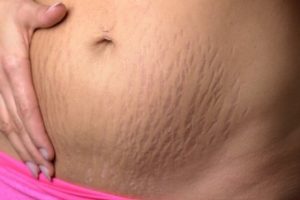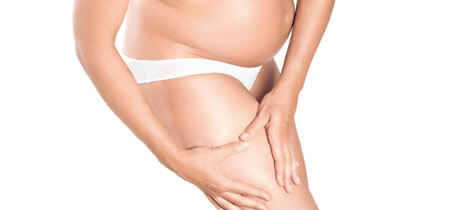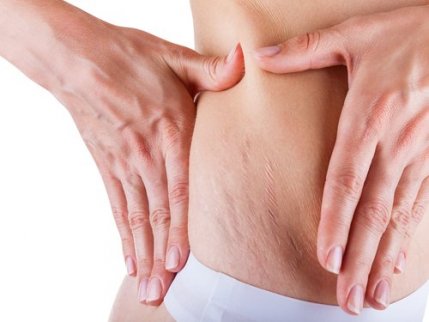Stretch Marks: What Are They and How Can They Be Treated?

Basically, these are the parts of the body that change size during pregnancy. These changes cause the skin on your body to stretch, resulting in stretch marks.
One of the most relevant factors when it comes to the appearance of stretch marks is weight gain during pregnancy. This means that the more pounds you gain during gestation, the higher your chances of developing stretch marks.
Genetics also play a key role in the appearance of stretch marks after pregnancy. In the same way, metabolism and hormones are also culprits.
Given that these factors are beyond your control, focus on learning some ways in which you can avoid or reduce the occurrence of stretch marks.
What exactly are stretch marks?
Stretch marks are lines in the skin that can take on a reddish or purplish color, or sometimes have a more whitish aspect.
They’re usually brought on by the stretching of the skin due to weight gain. As a result, the skin fibers break, leaving behind the scars we know as stretch marks.
5 ways to avoid post-pregnancy stretch marks
Although some stretch marks are inevitable, there are a series of precautions you can take in order to reduce the intensity of their appearance.
1. Control your weight gain
Keeping your weight under control is key, since excess weight gain during pregnancy is bad both for the mother and the baby. Furthermore, it contributes to the appearance of stretch marks, since your skin stretches more than it should.

2. Follow a healthy diet
Choose foods that are high in antioxidants. Antioxidants aid in the production of collagen and help make skin firm and elastic.
Therefore, opt for foods that are rich in vitamin A, C and E. The list includes fruits, vegetables, dairy products, meats, citric fruits, vegetable oils, seeds and leafy greens, among others.
3. Exercise
Stay active through moderate exercise to stay in shape. Choose light-impact activities such as going for a walk.
“One of the most relevant factors when it comes to the appearance of stretch marks is weight gain during pregnancy”
4. Hydrate your skin
It’s important that you drink plenty of water and liquids to stay hydrated. Doctors recommend at least 2 liters of water per day.
Furthermore, keep in mind that some of the foods you consume each day also contain liquids. Therefore, you shouldn’t force yourself to drink, but you should at least cover your daily dosage of water.
5. Use body lotions
Though your pregnancy is over, the stretch marks remain. To get past them, use creams that make these undesirable lines disappear, or at least reduce their appearance.
While their occurrence may be inevitable, options exist for getting rid of them or lightening them.
There is a variety of lotions and gels available on the market that you can use to eliminate stretch marks. Look for products that contain vitamin E or cocoa butter.
Cocoa butter is helpful in reducing the appearance of stretch marks both during and after pregnancy.

Ideally, you should apply these products twice a day until your stretch marks disappear or become nearly invisible. The sooner you begin treatment, the better your chances are of eliminating or lightening them.
Natural remedies are preferable over chemical treatments or surgery, as those options are more risky and less effective.
Caring for your skin during pregnancy doesn’t guarantee that you’ll be exempt from stretch marks. However, that doesn’t make being cautious a waste of time.
In conclusion, skin with stretch marks after pregnancy can often affect a woman’s self esteem.
If a woman is already dealing with postpartum depression due to hormonal changes after the birth of her child, seeing stretch marks in the mirror probably doesn’t help.
Just the same, it’s important to know that stretch marks are a normal symptom following pregnancy. To reduce their occurrence, hydrate your skin inside and out and maintain a healthy diet.
All cited sources were thoroughly reviewed by our team to ensure their quality, reliability, currency, and validity. The bibliography of this article was considered reliable and of academic or scientific accuracy.
- Antioxidantes. Food and Nutrition [Internet]. 2003 [citado 23 de enero de 2022]; Disponible en: https://medlineplus.gov/spanish/antioxidants.html
- Rubio P, Correia C. Embarazada, ¿y ahora qué?: Plan para cuidarse durante y después del embarazo. Penguin Random House Grupo Editorial España; 2016.
- Schoenfeld P. Colágeno: Rejuvenece tu piel, fortalece las articulaciones, y siéntete más joven gracias a la dieta que aumenta la producción y el consumo de colágeno. EDITORIAL SIRIO S.A; 2020.
This text is provided for informational purposes only and does not replace consultation with a professional. If in doubt, consult your specialist.








